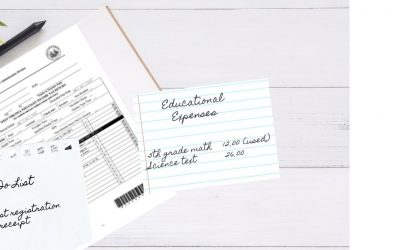It can be tempting to think that a test will accurately assess how we are doing as teachers and how our children are doing as students. But it can do neither. Standardized testing is only a tool to determine how our children compare academically with other students in the same grade level at the same time of the school year. The resultant scores are percentile rankings.
On the other hand, nationally normed tests can help us find relative strengths, weaknesses and learning gaps. For many families, they can be a wake-up call when busyness has pushed schoolwork into the background, for we want to be faithful with our God-given role of educating our children. Besides, testing can hone our children’s skills in group situations, as well as in test-taking strategies, both of which are necessary for future endeavors like college.
So what are practical ways to prepare? Simply learning a little strategy and becoming familiar with the format can make a big difference.
Understand the Directions
Children need to understand the directions before they begin the test. Although they feel free to ask for repetition at home, they may be less likely to do so in an unfamiliar situation. The administrator can restate the directions and clarify as long as no answers are implied, so encourage your child to ask if he doesn’t understand the directions.
Choose the Best Answer
*Good guesses
*No penalty for wrong answers
*First hunches are usually best
Your child will thoroughly understand and readily know the answer to many of the questions. He will be hesitant and confused by others. Prepare him for this and teach him to make good, but not wild, guesses. Teach him to eliminate obviously wrong answers and make reasonable guesses from the others. Since there is no penalty for wrong answers, so encourage him to answer all questions as best he can, and avoid leaving any blank if there’s time to finish. Unless he has confidence that his choice was not a good one, discourage him from switching answers. First hunches are often best.
Make Good Use of Time
*Easy questions first
*Mark skipped questions
*Don’t dally over bubbles
*Practice time constraints
*Dull lead for bubbles, sharp for math
If a question or problem is particularly difficult, it should be skipped and worked after easier questions are answered. There is a hazard, however: students must insure that they do not get off sequence on the answer sheet. Help them work out a system for staying on number sequence and flagging the skipped questions.
Marking the answer bubbles can also waste time. Perfectionistic marking is not necessary for the scoring machine to read the answer – although marking way outside the circles is not wise. Dull pencils are actually better for marking bubbles quickly; math problems are worked more quickly with sharp pencils.
We are not typically bound by time constraints at home, so practicing with time limits might prove helpful. Math is a good subject for timed practice. Math subtests generally allow 20-40 minutes, so within this time frame, have your child see how many problems he can work with attention to accuracy. Children who are meticulous or slow workers will need some training to work within time constraints. Younger children will also need help transcribing horizontally given math problems into vertical form to work. Giving them regular practice on a skill as straightforward as this can be a big boost. And they must learn to sit quietly and not distract others.
(IMPORTANT NOTE: grade 3, level 9, is the first level with a separate answer sheet. In the early grades, most of the test is read aloud by the administrator, and students move along together in their individual, self-contained booklets. The child, then, cannot skip answers and go back on most of the early levels.)
Become Familiar with the Test Format
Completing worksheets with a test format will give your child some practice and help him feel more secure at the onset of the testing session. For example, prepare groups of math problems with possible answers including a “not given” or “not here” choice. Language mechanics requires finding errors in punctuation or capitalization, so sample sentences can be made for practice.
Maps, charts and graphs are included on most levels of the Iowa and are now embedded in the subject tests rather than being a separate subtest. Learning how to read and interpret information presented in these formats is not only an academic requirement but an invaluable life skill. Help your children become familiar with directions on a map, types of legends, and different symbols and labels. Teach them how to make sense of pie charts, bar graphs, and other kinds of graphic representations of data.
Test levels through the third grade contain a listening subtest. Prepare for this by reading short paragraphs and asking questions afterward. Include simple inferences, drawing conclusions, and retention of meanings and details. For example, read a simple paragraph and follow with questions such as, “Which of these was done first,” “What color was the horse,” or “What do you think the child will probably do next?” Offer four choices. On the actual test, these readings cannot be repeated; teach your child to listen and attend the first time.
Finally, practice tests may help many students, especially if they have not tested previously. Practice booklets are widely available online or at bookstores.
Don’t Expect to Know it All
Remind your child (and yourself) that he is not expected to know everything on the test. Some of the test items will be beyond the grade level to accurately cap the higher scores. Students can answer several questions incorrectly or not at all and still do well on their scores because they are comparison scores. Your child’s score will be determined in comparison with other students who also got some answers wrong.
Even the academic subsections can vary from our specific curriculum’s scope and sequence. For instance, Christian homeschoolers often study history and geography intensively. But the IOWA, Stanford and Terra Nova cover only “social studies”. While this may include history and geography, it often centers more on social concepts like community service, minority group progress, recycling, and government and political issues. If we emphasize subjects differently from mainstream educators, we should adjust our expectations and view test results accordingly.
Finally, remember that your work is unto the Lord.
What happens throughout the entire year is a better indication of your faithfulness than what happens during testing week. And your child’s heart condition is vastly more important than his academic performance.
“Do not be anxious about anything, but in everything, by prayer and petition, with thanksgiving, present your requests to God. And the peace of God, which transcends all understanding, will guard your hearts and your minds in Christ Jesus.” Philippians 4:6-7
Rather than worrying, make testing week something to look forward to – with afternoons off or pizza at the end! Wise preparation can help make this a pleasant change of pace!
Note: For parents who want to use test prep materials, workbooks can be purchased at many bookstores such as Barnes & Noble or Books-A-Million. They can also be purchased from our test distributor, BJU Press Testing, here. Materials are available from Amazon via our Amazon Smile (see right sidebar). Once at Amazon, search for “standardized test practice.”





Recent Comments